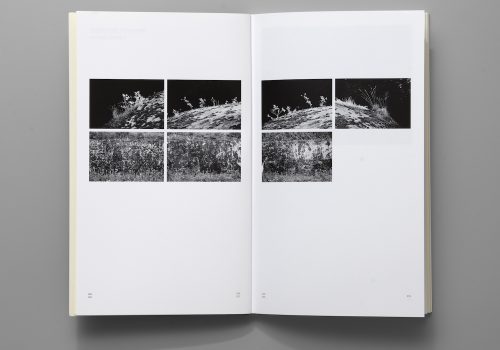Bunkers blackened with time, overgrown hedges, drab vegetation spewing out of crevasses: there is no color other than dark in Alexandre Guirkinger’s photographs. The remains of the Maginot Line, which failed to protect the French against the Germans, are like discolored scars on the face of the European twentieth century, convulsing with spasms and bathed in tears.
From aerial views to close-ups of moss, these austere images show totem ruins nestled in nature ever ready to engulf, having sized it up, whatever humans construct to separate “us” from “you” and defend their borders.
Photography knows how to retrace borders, but can it really help one understand what sets people apart or pits them against one another? Pictures of war, which capture the physical aspect of hostility, have a hard time explaining the hatred and fear distilled in the fighting: portrayed in motion, bodies in combat say nothing about the battles of the spirit, and the border between two souls seems a mystery inaccessible to the image. This is true of the engagement between two fighters as well as between two lovers: a husband who photographs his wife every day and knows her body down to the minutest detail will find that he is constantly denied access to her inner world; of the individual being, the photographed body seems to offer no more than trace evidence, and it protects her as much as it puts her on display.
“Like a kind of melancholy mirage, the other withdraws into infinity and I wear myself out trying to get there.”* To measure this line of demarcation using photography may well be an exercise that touches us to the core when it comes to borders; because no forbidden territory will ever be as distant as the Other: desired but unreachable, present but forbidden, adjacent but opposing.
Echoing these thoughts, an image resurfaces: Eleanor Callahan, photographed by her husband Harry in Chicago in 1949. Her eyes closed, her body immersed in water, she gives herself over to the gaze without a hint about her train of thought; she is physically within reach, but inaccessible to the mind. The viewer’s thought wanders to the bleary-eyed sentry surveying the terrain from a watchtower on The Line like a lover on the lookout for a sign in a frown or half a smile: both are confronted with the unfathomable mystery of a border dweller and both will hear themselves whisper an avowal of solitude: “In which corner of the adverse body should I read my truth?”*
Antoine Soubrier
Antoine Soubrier is a writer specializing in photography. He lives and works in Paris.
* Roland Barthes, A Lover’s Discourse: Fragments, trans. Richard Howard (New York: Hill and Wang, 1978) [1977].
Alexandre Guirkinger et Tristan Garcia, La Ligne
Published by RVB Books
€24
https://rvb-books.com/book.php?id_book=126
















